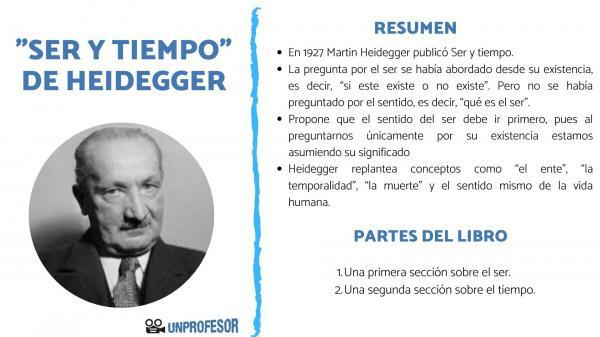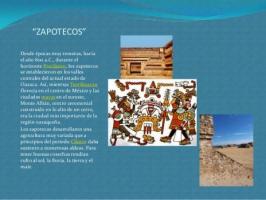BEING AND TIME by Martin Heidegger

The work of the German philosopher Martin Heidegger has permeated modern philosophy, as well as literature, architecture, psychology, and even theological studies. From an urbanization in the countryside and having a quiet life, he built a philosophical system that rethink the ontology and epistemology of his time. In this lesson from a Teacher we will do a summary of Being and time by Heidegger.
Index
- Heidegger's Summary of Being and Time
- What is Heidegger's being?
- What is time in Heidegger?
Heidegger's Summary of Being and Time.
Unlike a narrative book, summarizing Being and time It implies going through the central questions and concepts of it. Therefore, this article will focus on exposing Heidegge's philosophyr starting at questions, answers and concepts that he employs in his magnum opus.
As a disciple of the famous philosopher and pioneer of phenomenology Edmund Husserl, in 1927 Martin Heidegger published Being and time. We are faced with a complex book that warns that
Western philosophical tradition has forgotten a fundamental question: the question of being.For the German philosopher, the question of being had been addressed since its existence, that is, "if it exists or does not exist." However, until now he had not wondered about the meaning, that is, "what is being." With this, he proposes that the sense of being must come first, because by asking ourselves only about its existence we are assuming its meaning, without knowing exactly what it is.
Although it seems a tangled thought, Heidegger knows how to develop his argumentative threads and little by little he leads us along his philosophical slopes. To meet this goal, the book is divided mainly in two large sections:
- A first section on being.
- A second section on time.
This tour is done in order to show us that to reformulate that initial question about being we leads to rethinking concepts such as "the entity", "temporality", "death" and the very meaning of life human. These concerns will lead him to postulate the importance of the practicality of existence.

What is Heidegger's being?
As we indicated in the previous section, with the introduction of this question, Heidegger seeks to find the meaning of being. Thus it makes a difference between being and being, which is derived from the difference between the ontic (the existence of things by themselves) and the ontological (the meaning of the existence of those things).
For Heidegger, from the ontic dimension, the question of being cannot be answered, since he speaks to us of what simply exists: entities. On the contrary, an ontological approach asks about the meaning of these entities.
Thus, in Being and time the idea that Being is what determines the entity, what makes the entity be x or Y. In other words, "being something" is what determines the existence of a thing, only that "being something" can only be discovered through a human intellectual act; through an interpretation. And it is at this point that we find the backbone of all Heideggerian philosophy: the Dasein.
Dasein: the central concept of Being and time
Heidegger rescues a concept that already thinkers like Kant had worked on his philosophy. The Dasein used in the philosophical lexicon without translation due to its level of technicality, but if we had to give it a meaning it would be "to be there" or "to exist there".
For the German philosopher the Dasein means the state of throwing up in which the human being is in his existence. The meaning of man's life is to be thrown into his possibilities and the way in which he assumes or avoids them. In this condition he meets the things of the world that surround him, he can use an exercise on them, a utility that allows him to have a practical relationship with his environment.
In short, the Dasein he expresses that human existence is related to the conditions of its possibility. Human beings exist surrendered to the world with the freedom to decide what to do, with a projection of becoming. This idea connected Heidegger with thought existentialist that he developed during the 20th century.
What is time in Heidegger?
To continue with this summary of Being and time of Heidegger, let us now turn to the second section of the book. While the first part asked the question of being and put Dasein as the central concept, andn the second half of the book we find ourselves by the question with by time.
The consciousness of time
As Cordua points out in her lecture on this book, Heidegger “defines time as the horizon from which all degrees of understanding of being and commitments to the possibilities of becoming are conceived and assumed ”. This means that time is a kind of stage that allows human beings to conceive their own existence, the realization of him and his interpretation of the world around him.
Within our temporality the past, the present and the future inhabit. This makes the human being is free and determined at the same time. For he lives in a context where he is determined by his culture and the heritage of his ancestors, but also with a horizon of possibility of change and future transformation.
Here Heidegger introduces another of his great ideas: the awareness of time generates a certain existential anguish about life, since man understands his temporality; understand that his existence leads to death. As Cordua points out in her conference: “There is nothing decided in advance except the finitude of this one opportunity of mine. as existent, then, although walking towards death, I am in the meantime in charge of myself without any external help ”.
It is through death that we can give relevance to our life, conceive an authentic life where we do not renounce ourselves. Are Dasein thrown into the world with the freedom to decide, but with the determination of our past and our future perishing. Our existence goes towards death. Before being a cult of death or pessimism, the German philosopher finds in this gaze a possibility for the human being to fulfill himself and seek to be genuine.

If you want to read more articles similar to Heidegger: Being and time - summary, we recommend that you enter our category of Philosophy.
Bibliography
- Cordua, C. (2019). Being and time, conference. Diego Portales University.
- Heidegger, M. Being and time.
- Lozano, V. (2004). Heidegger and the question of being.
- Stanford Encyclopedia of Philosophy. (2011). Martin Heidegger.


![GOTHIC art architecture: characteristics and examples [with IMAGES]](/f/9b9552a0e923ec39efa06c3d69cd711f.jpg?width=300&height=200)
